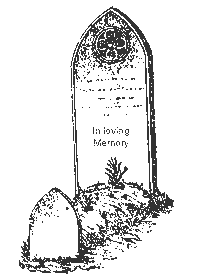
| Public memorials, epitaphs | Back | Home |
Epitaphs have changed over time. In the 17th century most were brief and factual. Very few mentioned faith, possibly because people were afraid of being accused of 'popery'. Many epitaphs mention mortality and its inevitability.
In the 18th and 19th century epitaphs became increasingly verbose, vainglorious, tender or brutal and, frequently, witty. It also became more acceptable to mention faith. People have always debated what makes a suitable epitaph. In 1631 it was suggested that an epitaph should consist of "the name, the age, the deserts, the dignities, the state, the praises both of body and mind, the good or bad fortunes in the life, and the manner and time of the death…". However it was also argued that an epitaph should "show love to the deceased, memory to posterity, and comfort to friends" and that "the shortest, the plainest and truest are the best". |
 |
|
Copyright & Terms & Conditions of use
Copyrights to all of the resources on this web site are retained by the individual rights holders.
They have kindly made their collections available for everyone to share and enjoy. Please respect
copyright.


